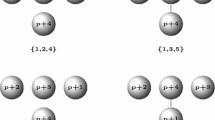Abstract
Egon Balas’s additive algorithm, also known as implicit enumeration, is a technique that uses a branch-and-bound (B&B) approach to finding optimal solutions to 0–1 integer programming problems. Three common search strategies in B&B are depth-first search, breadth-first search and best-first search. The B&B approach generates a list of pending nodes to be evaluated and storage of these nodes becomes a memory issue for larger problems. In this paper, we propose a simple bookkeeping method that tracks the state of the problem using a single array when performing a depth-first search, dramatically reducing memory requirements. The method also provides the ability to calculate, at any point of the search, the theoretical maximum number of remaining nodes to be evaluated. We note in this paper that when using the best-first search strategy, the first candidate solution found is the optimal solution.








Similar content being viewed by others
References
Balas E (1965) An additive algorithm for solving linear programs with zero-one variables. Opns Res 13:517–546
Bradley SP, Hax AC, Magnanti TL (1977) Applied mathematical programming. Addison-Wesley (Section 9.7)
Chinneck JW. 2015. Practical optimization: A gentle introduction. Draft. Not published. All chapters available at http://www.sce.carleton.ca/faculty/chinneck/po/. (Chapter 13).
Dechter R, Pearl J (1985) Generalized best-first search strategies and the optimality of A∗. J ACM 32:505–536
Fagerberg N, Odenbrand D (2016) Binary integer programming in associative data models. Master’s Thesis, Dept Computer Science. Lund University
Geoffrion AM (1967) Integer programming by implicit enumeration and balas’ method. SIAM Rev 9(2):178–190
Glover F (1965) A multiphase-dual algorithm for the zero-one integer programming problem. Oper Res 13(6):879–919
Hillier FS, Liberman GJ (2001) Introduction to operations research, 7th edn. McGraw Hill, New York (Section 12.6)
Ibaraki T (1976) Theoretical comparisons of search strategies in branch-and-bound algorithms. Int J Comput Inf Sci 5:315–344
Land AH, Doig AG (1960) An automatic method for solving discrete programming problems. Econometrica 28(3):497–520
Lawler EL, Wood ED (1966) Branch-and-bound methods: a survey. Oper Res 14:699–719
Mannur NR (1993) Implicit enumeration algorithms for solving 0–1 integer programming problems. PhD Thesis. State University of New York at Buffalo.
Morrison DR, Jacobson SH, Sauppe JJ, Sewell EC (2016) Branch-and-bound algorithms: a survey of recent advances in searching, branching, and pruning. Discret Optim 19:79–102
Murty KG (1995) Operations research deterministic optimization models. Prentice Hall Section 10:7
Nemhauser G, Wolsey L (1988) Integer and combinatorial optimization. Wiley (Section 11.4)
Taha HA (1975) Integer programming, applications and computations. Academic Press, New York (Ch3)
Tuan NPh (1971) A flexible tree-search method for integer programming problems. Oper Res 19(1):115–119
Winston WL (1991) Operations research: applications and algorithms. PWS-Kent Pub Co. Ch9
Author information
Authors and Affiliations
Corresponding author
Additional information
Publisher's Note
Springer Nature remains neutral with regard to jurisdictional claims in published maps and institutional affiliations.
Rights and permissions
About this article
Cite this article
Glover, J., Quan, V. & Zolfaghari, S. Some new perspectives for solving 0–1 integer programming problems using Balas method. Comput Manag Sci 18, 177–193 (2021). https://doi.org/10.1007/s10287-021-00389-6
Received:
Accepted:
Published:
Issue Date:
DOI: https://doi.org/10.1007/s10287-021-00389-6




